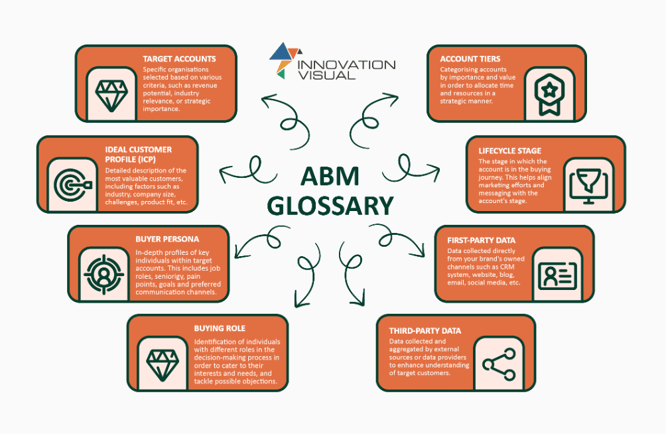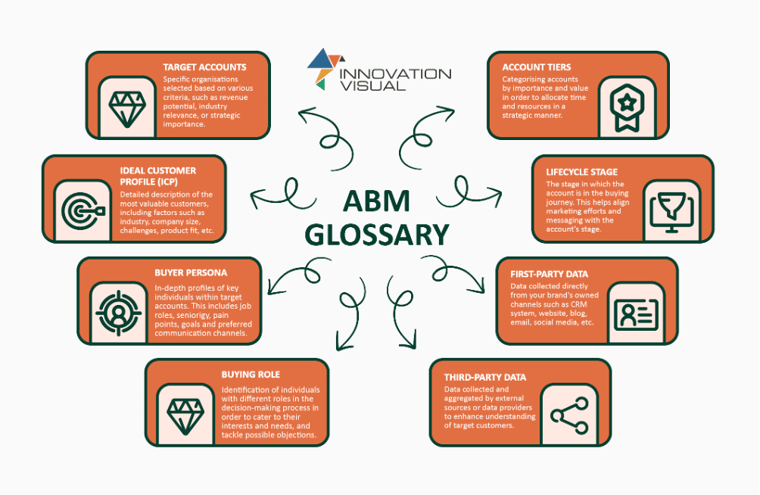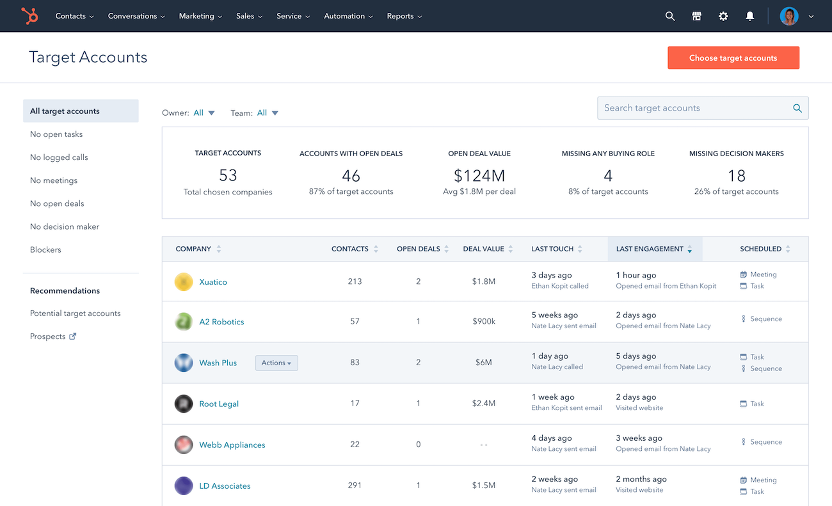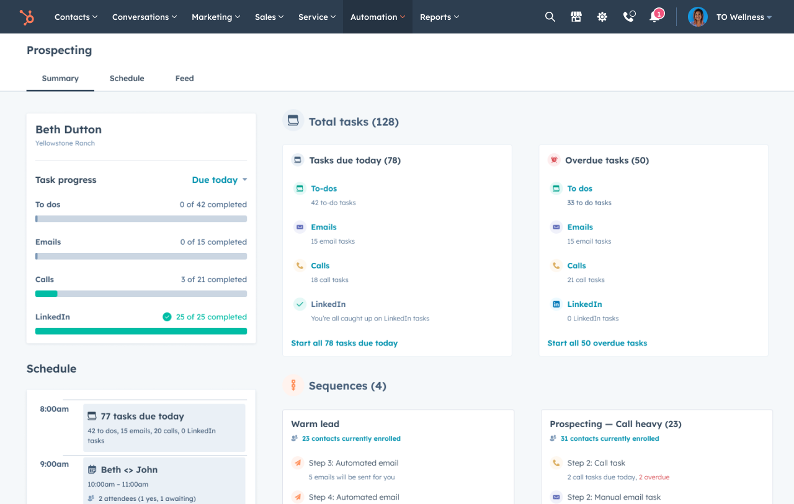
Account-Based Marketing (ABM) has emerged as a game-changing strategy for businesses looking to grow and foster stronger customer relationships. In this blog post, we will delve into the world of account-based marketing, exploring its key principles, benefits, and implementation strategies.
Understanding Account Based Marketing
What is Account Based Marketing?
Account-Based Marketing (ABM) is a strategic approach that focuses on targeting specific high-value accounts and tailoring marketing efforts to engage and nurture these accounts throughout their buying journey. Unlike traditional marketing, which often casts a wide net, ABM is a far more customised marketing approach.
What are the Benefits of Account Based Marketing Strategy?
ABM offers a plethora of benefits for businesses. The rapid advancement of sales and marketing technologies has enabled companies of all sizes to utilise account-based marketing to its fullest extent. By combining automation, smart segmentation, predictive scoring, engagement, and intent data, targeted accounts can be acquired and retained more effectively than ever before. Let’s look at some of the benefits in more detail.
1. Target Accounts:
Target accounts are the specific companies or organisations that a business aims to engage and convert into customers. These accounts are carefully selected based on various criteria, such as revenue potential, industry relevance, or strategic importance.
2. Ideal Customer Profile (ICP):
An Ideal Customer Profile (ICP) is a detailed description of the characteristics that define a business' most valuable customers. This includes factors such as industry, company size, challenges, product fit, etc. Developing a clear ICP helps marketers and sales professionals identify the right accounts and tailor their messages to resonate with these ideal customers.
3. Buyer Personas:
Personas represent different individuals within your accounts who influence or make purchasing decisions. Your buyer personas need to go further than just listing demographics, they should include information such as job roles, seniority, responsibilities, pain points, goals, and preferred communication channels. In contrast to the ICP, personas provide insight into the people within the organisations you want to target. The ICP provides firmographic data (e.g., industry, size), whereas personas examine human motivations and challenges within specific target accounts. Understanding your personas will enable you to segment your data and personalise communications further.
4. Buying Role:
In B2B purchases, various individuals can play specific roles in the decision-making process. Hence, a robust ABM strategy can't employ one-size-fits-all tactics; instead, it must identify these roles (decision-makers, influencers, and blockers) and tailor messages to their unique needs, motivations, and objections.
Accordingly, having a clear understanding of these roles also offers a practical advantage when managing target accounts in your CRM. For instance, when contacts associated with your target account are identified as part of the decision-making unit, you can focus your resources and efforts on engaging with them, thereby increasing your chances of success.
5. Account Tier:
Accounts aren't all equal in terms of strategic importance or potential value. Account-based marketing allows you to categorise accounts into tiers, such as Tier 1 (high-value, strategic accounts), Tier 2 (mid-value), and Tier 3 (low-value, long-term accounts). Depending on their importance to your business objectives, each tier may receive a different level of attention and customised strategies.
6. Lifecycle Stages:
ABM also considers where each target account stands in its buying journey. It may be in the early awareness stage, actively evaluating solutions, or accounts may be further down the funnel and closer to a deal closing. In order to increase the likelihood of conversions, you need to align your account-based marketing efforts with the specific lifecycle stage of each account.
7. First-party data:
First party data is collected directly from lead, prospect, and customer interactions. The company generates this data through its website, CRM system, marketing automation tools, and other channels it owns. Because it is derived directly from your audience's interactions with your brand, it is considered the most valuable and reliable type of data for ABM.
8. Third-party data:
Data collected and aggregated by external sources or data providers is known as third-party data. It is usually purchased by businesses as a supplement to their first-party data. A company can use third-party data sources, such as data aggregators, data brokers, industry-specific data providers, and more, to enrich and expand its understanding of its target customers

Getting Started with Your ABM Strategy
To kickstart your ABM journey, it is crucial to establish a well-defined account-based marketing plan. Here are the key components that will pave the way for success:
1. Data Cleansing
Account-based marketing (ABM) relies heavily on accurate and high-quality data. Hence, it's crucial that before implementing your strategy, you assess the completeness and readiness of your database to enable this programme. Data cleansing involves reviewing and refining customer data to eliminate errors, duplicates, and outdated details. This step ensures that you have access to reliable information about your target accounts and that your marketing efforts are built on a solid foundation.
2. Account Selection
Identify and prioritise your key target accounts that are aligned with your business goals and have the potential for significant revenue growth. Consider factors such as company size, industry, and fit for your product or service. To produce an accurate ICP, examine your existing customers to identify your highest-quality accounts and find the common characteristics. Engaging with your sales team in this process is an excellent way to tap into valuable frontline experience and expertise about your customers and prospects, as well as building a stronger foundation for cross-functional collaboration between marketing and sales.
3. Personalisation and Content Strategy
The next crucial step in your account-based marketing strategy is to craft bespoke messaging and relevant content that resonates specifically with each target account. Leveraging insights gathered from account research, the goal is to create meaningful interactions that speak directly to the unique needs and pain points of individuals within the target organisations. Audit your existing content assets to find resources that align with your target accounts' personas and buying roles. Assess your existing library of resources, including blog posts, whitepapers, case studies, webinars, and even sales collateral. This step can help identify available content as well as existing content gaps.
4. Target Account Prioritisation
Account-based marketing (ABM) is a dynamic and highly effective strategy, but it can also be resource-intensive. Thus, it is crucial to prioritise target accounts effectively to ensure limited resources are focused on the most profitable or highest potential accounts. Depending on your target accounts' tier, you can modulate the level of personalisation and resources allocated:
-
The 1:Many Approach (Tier 3 Accounts)
Utilising the 1:Many approach in ABM, marketing efforts can be leveraged across multiple accounts, allowing for scalability and efficiency. This approach consists of tailoring messaging and content to resonate at scale with the target audience by identifying similarities among accounts.
-
The 1:Few Approach (Tier 2 Accounts)
Using a 1:Few approach, target accounts are narrowed down to a smaller group with more specific attributes or higher conversion potential in order to give them a more personalised experience. A 1:Few approach requires a deeper understanding of your target accounts and their unique pain points. Therefore, a continuous profiling and record enrichment strategy is key to gaining more insights into your accounts and associated personas over time.
-
The 1:1 Approach (Tier 1 Accounts)
The 1:1 approach in ABM is the most personalised and resource-intensive approach. It involves treating each target account as a market of one and tailoring the marketing strategy to meet their specific needs and preferences. This approach requires in-depth research and a close collaboration between marketing and sales teams. While it demands significant resources, the 1:1 approach can deliver exceptional results, especially for high-value accounts and complex, longer sales cycles.
5. Cross-Functional Alignment
Your organisation must foster strong collaboration between your marketing and sales teams. Align on goals, establish clear communication channels, and regularly share insights and feedback to refine your account-based marketing strategy. The marketing function can assist sales by generating demand, qualifying high-quality leads, and nurturing prospects for an accelerated buying process. Likewise, the sales team can also provide insight into the buyer journey, share trends and behaviour, and provide feedback on campaign effectiveness to allow marketing to recalibrate the strategy as needed to deliver higher quality leads into the pipeline.
Evaluating Your Technology Stack for Account-Based Marketing Success:
Account-based marketing isn't just about enthusiasm and strategy. Your tech stack plays a significant role in your success. This section explores how to determine whether your current technology stack is ready to support your ABM strategy.
1. CRM System:
Begin by examining your Customer Relationship Management (CRM) system. ABM relies heavily on accurate data, segmentation, and interaction tracking. Ensure your CRM allows you to create and manage custom properties, effectively track real-time engagement at both the contact and account levels, and efficiently segment target accounts based on aspects such as firmographics, tier, lifecycle, score, intent, and engagement events.
2. Sales and Marketing Automation Capabilities:
ABM often involves running targeted and coordinated campaigns across multiple accounts simultaneously. A robust marketing and sales automation platform can help streamline these efforts, automate repetitive tasks, and trigger internal notifications for your team when key engagement events occur. Check if your existing platform supports workflows, sequences, automated lead nurturing, and personalised messaging at scale.
3. Personalisation Tools:
Personalisation is at the heart of ABM. Evaluate your current personalisation capabilities. Consider investing in personalisation software that allows you to dynamically adapt your website, emails, content, and other assets via personalisation tokens and smart content.
4. Account Scoring Capabilities:
Advanced marketing automation platforms often include robust account scoring features. These features allow you to score the interactions and behaviours of your target accounts, helping you identify those who are most likely to convert. Ensure that your platform allows you to customise and automate your scoring criteria to prioritise accounts that are most likely to generate revenue.
5. Integration Capabilities:
Your CRM should facilitate smooth integration between various tools. ABM often involves the use of multiple platforms for lead generation, data enrichment, intent data capture, and other utilities. Consider a platform which offers a range of native integrations that can bridge gaps between different systems to achieve a cohesive ABM experience.
6. Account Tracking and Analytics:
Ensure your CRM contains analytics tools that provide account-level insights, such as website visits, content engagement, and lead progression, so that you can evaluate and track its effectiveness. Additionally, make sure you can attribute revenue and ROI to specific campaign assets to see what's performing.
7. Scalability:
Finally, it is very important to consider whether your tech stack is capable of handling the growth of your ABM strategy as you expand your target account list and leverage more personalised campaigns.
Want to know more? Watch our Digital Marketing Answered session on the importance of auditing your technology stack and how it can give your company a competitive edge while maintaining cost-efficiency.
Discover the Power of HubSpot for ABM
As a HubSpot Partner Agency, we know that HubSpot is an ideal platform for your business’ ABM campaigns. By leveraging its smart CRM, automation and personalisation tools, advanced account scoring features, seamless integrations, and robust reporting capabilities, organisations can attract, engage, and delight their target accounts better and build more long-term relationships with their existing clients. Let's explore some of the main HubSpot features that can help you deliver an effective ABM strategy.
1. Smart CRM:
With HubSpot's smart CRM features, you will be able to manage your target accounts with precision, ensuring accurate data, segmentation, and interaction tracking. You can manage custom properties, monitor real-time engagement, program logic-driven actions to enrich your records and keep them up to date, and segment contacts and target accounts efficiently based on a variety of criteria.
2. Target Accounts Index Page:
HubSpot features a dedicated target accounts index page that serves as the command centre for your marketing and sales teams, enabling them to keep track of the accounts they want to work on and quickly filter through them to determine next steps.

3. Smart Forms:
HubSpot forms are designed to enhance first-party data collection efficiency. They feature conditional fields that adapt based on user responses, hidden fields for implicit data gathering, and progressive fields that gradually collect information about your contacts over time. These capabilities streamline the user experience, making it easier to capture essential data for your ABM campaigns.
4. Lifecycle Stages:
HubSpot lets you manage and define automated lifecycle stages. It enables your team to tailor messaging and engagement strategies according to where each account is in its buying journey.
5. Lead Scoring and Segmentation:
Using HubSpot's lead scoring capabilities, you can identify your most promising prospects and automate your lead qualification process. Automating your lead scoring criteria allows your team to stay laser-focused on revenue-generating accounts.
6. Personalised Content:
HubSpot offers a wide array of personalisation tools, such as personalisation tokens and smart content, that allow you to dynamically adapt your website, emails, content, and other assets to cater to the needs of each target audience. Additionally, you can perform A/B testing to determine which elements are most effective.
7. Email Marketing:
HubSpot's email marketing features supercharge your ABM campaigns. Get real-time insights into deliverability, open rate, and subscription status, leverage smart elements like custom calls to action, use A/B testing to improve nurture tactics for different target accounts, and more.
8. Workflows and Sequences:
With HubSpot workflows and sequences, you can automate tasks and processes across marketing and sales functions to execute targeted and coordinated ABM campaigns.
9. Prospecting Workspace:
HubSpot's prospecting workspace allows sales users to efficiently manage their daily workload. This dedicated area provides sales professionals a focused environment to review and manage their leads, tasks, goals, and progress in one central place. This supports ABM by providing sales teams with an organised way to stay on top of their engagements with key accounts, track progress, and measure the success of their outreach efforts.

10. CRM Integrations:
Featuring over 1,000 apps, HubSpot CRM natively integrates with commonly used ABM tools like Bombora, ZoomInfo, Trendemon, and 6Sense. It also integrates with other popular CRM systems, like Salesforce, Microsoft Dynamics 360, Zoho, Pipedrive, etc. Furthermore, APIs can be used to perform custom integrations and customise the platform to your business’ specific needs.
11. Advanced Analytics and Custom Reporting:
HubSpot's CRM includes comprehensive analytics tools for tracking contact and account-level insights, such as website visits, content engagement, journeys, lifecycle progression and more. You can create custom reports to meet your specific requirements or choose from a wide range of out-of-the-box contact, company, deals, and revenue reports available in the library. Is also includes attribution reporting that enables you to identify which assets from ABM programmes are driving the most revenue and ROI.
Ready to unleash your Account-Based Marketing potential?
With a deep understanding of HubSpot's platform and a proven track record of excellence as a digital marketing services provider, Innovation Visual is your trusted partner for building and implementing custom ABM strategies that maximise the HubSpot platform's functionality.
We collaborate with you to pinpoint your target audience, optimise your campaigns, and measure success. You can count on our team's extensive digital marketing expertise to help you manage all aspects of your account-based marketing strategy, including paid search and social campaigns, web design, email, and any other element you may require.
Whether you're an existing HubSpot user seeking to implement ABM or looking for a platform to enable your ABM programme, Innovation Visual brings the expertise and experience necessary to help you achieve your business goals effectively. Contact us today to get started.

.png?width=250&height=141&name=image-gen%20(1).png)








